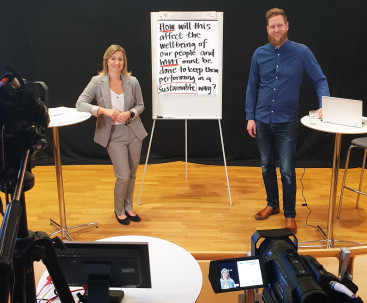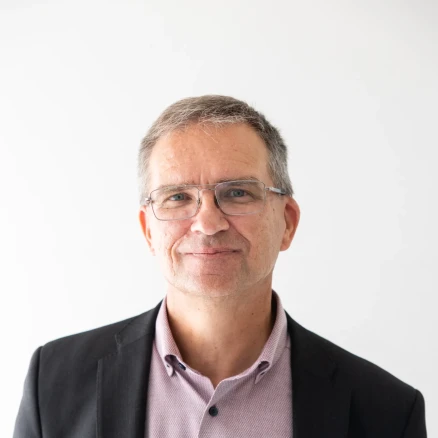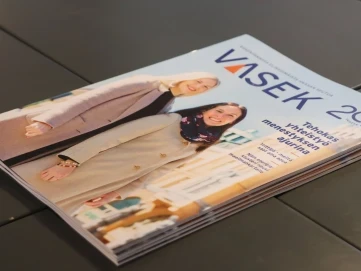Everyone Benefits from Sustainable Leadership: Employee, Employer, and Ultimately Work Itself
The Future Cleantech Solutions project webinar on 7 October 2021 addressed sustainable leadership in a changing world under the guidance of lecturer, change leader and educator Ulrika Sedin. Jon Moraeus, the international business developer at Future Cleantech Solutions, moderated the webinar. Interest on both sides of Kvarken was high; more than 300 participants from Sweden and Finland enrolled in the event.
 Ulrika, Jon and the most important question
Ulrika, Jon and the most important question
The Future Cleantech Solutions project webinar on 7 October 2021 addressed sustainable leadership in a changing world under the guidance of lecturer, change leader and educator Ulrika Sedin. Jon Moraeus, the international business developer at Future Cleantech Solutions, moderated the webinar. Interest on both sides of Kvarken was high; more than 300 participants from Sweden and Finland enrolled in the event.
Sustainable work is about creating and renewing human resources, not consuming them. Sustainable management is about developing good long-term outcomes, taking care of oneself, and learning how to use tools to build a business with sustainable workers who are seen and met as individuals. As a leader, you influence your environment and contribute to its sustainability, equality and diversity.
–What does a Formula One race has to do with sustainable leadership? Ulrika Sedin asks. To succeed in your job, you have to know how to focus, brake and take a rest in the right places because the digital world we live in is as fast-paced and ever-changing as an F1 race. The leaders must be F1 drivers who lead both themselves and others in a sustainable way.
According to Sedin, the world can be described in English by the term VUCA meaning it is volatile, uncertain, complex, and ambiguous. Sedin poses an important question: What kind of leadership is necessary in such a world?
Sedin says that this world has to be met by a vision, transparent leadership and clear communication to know which way to go as things change. Even the simple things can get complicated, but this can be fought by focusing on what really counts and working in teams. In addition, the work community should also be flexible enough to accept possible mistakes and set short-term goals to re-evaluate choices in an effort to reach the greater vision.
Especially recently, the skills of living within the VUCA world have been needed.
–We never saw the pandemic come, but we still had to deal with it. Within this context, sustainable leadership is the ability to deliver results over time in such a way that the well-being of the leader and the members within the organisation is not compromised, Sedin says.
Employees Should Be Taken Care of
It has to be remembered that stress and productivity are interrelated. The cost of falling productivity levels is, in fact, higher that of sick leaves. The organisational culture must support employees in their best possible performance. Sustainable leadership requires a certain kind of organisational structure, but it is important to take into account because it is highly linked to efficiency and profitability.
The stress experienced at work has two sides; it can be a power boost for achieving results. On the other hand, long-term stress at a too high level can also keep you from reaching your goals. If we are not led well, we will find ourselves in this situation.
Tools for Sustainable Leadership
Sustainable leadership is strongly linked to the well-being of everyone within the organisation and managing benefits and threats of the outside world. This requires analysis of the organisation's current state, after which not only the physical environment but also mental ergonomics can be improved. It does not concern only the employees, but also the leader needs to make sure to stay healthy to work in the best way possible. If the environment is in order, it is easier to stay effective.
According to Sedin, mental ergonomics include work techniques, work culture, and work management.
– The leader must enable a route to a clear goal, for example, by clarifying the content and objectives of meetings. Limiting the use of digital systems may also be appropriate in some cases if they only cause digital stress. Expectations must be clear, too; when do you have to be reachable to others and when not? If the expectations are clear, it is also easier to prioritize and limit your workload, she notes.
We have a social need to operate with other people, so the working culture has to make it possible.
In the most efficient companies, the employee has a sense of successful teamwork and everyone feels safe and has an opportunity to focus and improve themselves through feedback. If the feedback is good, the employee will probably want to experience the same again.
Within work management, you need to pay attention to the reasonable demands and workload. At this point, Sedin mentions the Swedish term lagom, which means something that is neither too much nor too little.
– The goal is to have a sense of control over things. Professional stress leads down to the push back mode, in which case it would be good to be able to ask for help from colleagues. The leader must therefore provide the right kind of training, in accordance with the needs, but also maintain a work culture in which it is allowed to ask for help. If the to do list is too long, we start avoiding and procrastinating about doing them because our brains feel like we don't control things or we have too much to do. There must be room for rest and recovery like there are pit stops in the F1 race.
After all, according to Sedin, the most important question when making decisions is the following one:
– How will this affect the well-being of our people in our work community, and what must be done to keep them performing in a sustainable way? Because if you are going to do something in the long-term, you have to do it sustainably and not like an F1 driver who gets off the track.
This event was organised through the project Future Cleantech Solutions, financed by Interreg Botnia-Atlantica, Region Västerbotten, Umeå municipality, Umeå Energi, Skellefteå municipality, Skellefteå Kraft, Region Västernorrland, Örnsköldsviks municipality, Regional Council of Ostrobothnia, Vaasa Region Development Company VASEK, Technology Centre Merinova, The City of Vaasa, City of Kokkola and Kokkola Region Development Company KOSEK.


